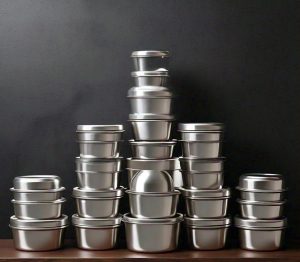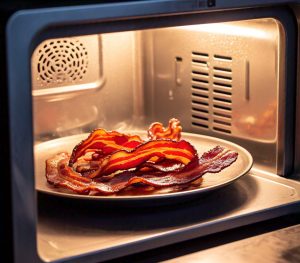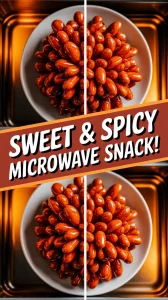Aluminum containers are lightweight, versatile, and often used in the food service industry for packaging and storing meals.
The question that arises here is whether you can microwave these aluminum containers or not.
This article will delve into discussing Aluminum containers in detail, explaining if they can be subjected to microwaving and what happens when you do so. If it’s safe to microwave them, we’ll provide information on how long you could potentially heat these containers without causing harm or damage. In case it isn’t recommended to microwave them, we will offer alternatives for heating your food stored in these containers along with necessary tips and precautions. Plus, frequently asked questions related to this topic will also be addressed for better clarity. Lastly, our final word summarizes the key points discussed.

Jump To:
Is Microwaving Aluminum Containers Safe?
No, it’s not safe to microwave aluminum containers. Microwaves bounce off metal objects, causing sparks which might lead to a fire. Instead of using an aluminum container in a microwave, you could use glass or ceramic dishes that are labeled as ‘microwave safe’. This way, you can ensure your food heats evenly and safely.
Facts About Microwaving Aluminum Containers
Here, we will discuss the important things to note about microwaving aluminum containers.
- Heat Conduction: Aluminum is a good conductor of heat, ensuring that it heats up quickly when microwaved. However, this can lead to uneven heating or hot spots.
- Safety Concerns: Microwaving aluminum containers can be dangerous as they may cause sparks and potentially start a fire. This is because microwaves bounce off metal surfaces causing arcing.
- Metal Interference: The metal in aluminum containers interferes with microwave radiation and prevents evenly distributed heating throughout food items inside them. It might leave some parts cold while others overcooked.
- Potential Damage to Microwave: If used incorrectly, aluminum in the microwave could damage the appliance permanently by causing burns or arcs inside your oven’s walls.
In conclusion, these are just some of the key points to consider when thinking about whether you should microwave an aluminum container.
Now we will discuss some other things about microwaving aluminum containers.
What are the Alternatives to Microwaving Aluminum Containers?
In lieu of microwaving aluminum containers, several other options are available. For reheating food, a conventional oven or toaster oven can be used as an effective alternative. These appliances heat food evenly and do not react adversely with aluminum containers. Another method is using stovetop heating; this works well for foods that need stirring. Lastly, non-metallic microwave-safe dishes are ideal substitutes for microwaving as they don’t pose any risk associated with metal in a microwave.
Tips to Microwave Using Non-Aluminum Containers
When choosing to move away from aluminum containers for microwaving purposes, here are some useful tips:
- Select microwave-safe containers: Look for symbols at the bottom indicating suitability for microwave use.
- Avoid plastic wraps: They could potentially melt onto the food when subjected to high temperatures.
- Ventilation is vital: Use vented lids or leave one corner of the cover open to allow steam to escape.
- Distribute Food Evenly: This aids uniform heating and avoids cold spots.
- Stir Regularly: Stirring enables heat distribution throughout your meal hence promoting even cooking.
We have now covered our main points relating aluminum container usage in a microwave and its alternatives along with some helpful tips.
Check out if you can put an aluminum tray in the microwave.
In our next section, we will discuss frequently asked questions related to these topics.

Frequently Asked Questions (FAQs)
In this section, we will now look at the most commonly asked questions related to microwaving aluminum containers.
Can you microwave aluminum containers?
No, you cannot microwave aluminum containers. When microwaves hit an aluminum container, they get reflected off instead of penetrating through. This can cause uneven heating in the food and potentially damage your microwave oven. It’s better to transfer food into a microwave-safe dish before heating.
What happens if you microwave aluminum foil?
Microwaving aluminum foil can lead to a fire hazard. The electric fields in microwaves cause currents of electricity to flow through the foil which causes heat and sparks. If these sparks hit something else inside the oven—like wax paper—they could ignite a fire.
Is there any metal safe for microwaving?
Few metals are safe for use in a microwave; however, some ceramics with thin metal trims or compositions may be labeled as “microwave safe.” Always check manufacturer guidelines before using items with any metal components in your microwave.
Check out if you can microwave metal cups.
Why do some microwavable meals come in metal trays?
Certain frozen meals come in specially designed trays that include metal because manufacturers have studied how their particular product reacts inside the tray during microwaving conditions. These should only be used if explicitly labelled as “microwave-safe”.
We hope this FAQs section has addressed all your queries concerning microwaving and different types of materials which are safe for such use.
Final Word
In conclusion, while it might seem convenient to directly heat up foods or leftovers within their original packaging – like an aluminum takeaway box – it is advised against due to potential risks and uneven heating. It is also important to always pay attention to manufacturer guidelines on packaging regarding microwave safety. Ensuring such precautions will help keep your food heated evenly, your kitchen safe and extend the longevity of your microwave oven.



